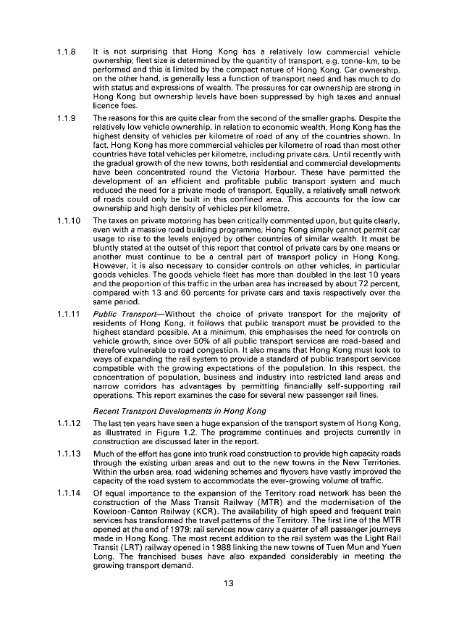Untitled - HKU Libraries - The University of Hong Kong
Untitled - HKU Libraries - The University of Hong Kong
Untitled - HKU Libraries - The University of Hong Kong
- No tags were found...
You also want an ePaper? Increase the reach of your titles
YUMPU automatically turns print PDFs into web optimized ePapers that Google loves.
1.1.8 it is not surprising that <strong>Hong</strong> <strong>Kong</strong> has a relatively low commercial vehicleownership; fleet size is determined by the quantity <strong>of</strong> transport, e.g. tonne-km, to beperformed and this is limited by the compact nature <strong>of</strong> <strong>Hong</strong> <strong>Kong</strong>. Car ownership,on the other hand, is generally less a function <strong>of</strong> transport need and has much to dowith status and expressions <strong>of</strong> wealth. <strong>The</strong> pressures for car ownership are strong in<strong>Hong</strong> <strong>Kong</strong> but ownership levels have been suppressed by high taxes and annuallicence fees.1.1.9 <strong>The</strong> reasons for this are quite clear from the second <strong>of</strong> the smaller graphs. Despite therelatively low vehicle ownership, in relation to economic wealth, <strong>Hong</strong> <strong>Kong</strong> has thehighest density <strong>of</strong> vehicles per kilometre <strong>of</strong> road <strong>of</strong> any <strong>of</strong> the countries shown. Infact, <strong>Hong</strong> <strong>Kong</strong> has more commercial vehicles per kilometre <strong>of</strong> road than most othercountries have total vehicles per kilometre, including private cars. Until recently withthe gradual growth <strong>of</strong> the new towns, both residential and commercial developmentshave been concentrated round the Victoria Harbour. <strong>The</strong>se have permitted thedevelopment <strong>of</strong> an efficient and pr<strong>of</strong>itable public transport system and muchreduced the need for a private mode <strong>of</strong> transport. Equally, a relatively small network<strong>of</strong> roads could only be built in this confined area. This accounts for the low carownership and high density <strong>of</strong> vehicles per kilometre.1.1.10 <strong>The</strong> taxes on private motoring has been critically commented upon, but quite clearly,even with a massive road building programme, <strong>Hong</strong> <strong>Kong</strong> simply cannot permit carusage to rise to the levels enjoyed by other countries <strong>of</strong> similar wealth. It must bebluntly stated at the outset <strong>of</strong> this report that control <strong>of</strong> private cars by one means oranother must continue to be a central part <strong>of</strong> transport policy in <strong>Hong</strong> <strong>Kong</strong>.However, it is also necessary to consider controls on other vehicles, in particulargoods vehicles. <strong>The</strong> goods vehicle fleet has more than doubled in the last 1 0 yearsand the proportion <strong>of</strong> this traffic in the urban area has increased by about 72 percent,compared with 13 and 60 percents for private cars and taxis respectively over thesame period.1.1.11 Public Transport—Without the choice <strong>of</strong> private transport for the majority <strong>of</strong>residents <strong>of</strong> <strong>Hong</strong> <strong>Kong</strong>, it follows that public transport must be provided to thehighest standard possible. At a minimum, this emphasises the need for controls onvehicle growth, since over 50% <strong>of</strong> all public transport services are road-based andtherefore vulnerable to road congestion. It also means that <strong>Hong</strong> <strong>Kong</strong> must look toways <strong>of</strong> expanding the rail system to provide a standard <strong>of</strong> public transport servicescompatible with the growing expectations <strong>of</strong> the population. In this respect theconcentration <strong>of</strong> population, business and industry into restricted land areas andnarrow corridors has advantages by permitting financially self-supporting railoperations. This report examines the case for several new passenger rail lines.Recent Transport Developments in <strong>Hong</strong> <strong>Kong</strong>1.1.12 <strong>The</strong> last ten years have seen a huge expansion <strong>of</strong> the transport system <strong>of</strong> <strong>Hong</strong> <strong>Kong</strong>,as illustrated in Figure 1.2. <strong>The</strong> programme continues and projects currently inconstruction are discussed later in the report.1.1.13 Much <strong>of</strong> the effort has gone into trunk road construction to provide high capacity roadsthrough the existing urban areas and out to the new towns in the New Territories.Within the urban area, road widening schemes and flyovers have vastly improved thecapacity <strong>of</strong> the road system to accommodate the ever-growing volume <strong>of</strong> traffic.1.1.14 Of equal importance to the expansion <strong>of</strong> the Territory road network has been theconstruction <strong>of</strong> the Mass Transit Railway (MTR) and the modernisation <strong>of</strong> theKowioon-Canton Railway (KCR). <strong>The</strong> availability <strong>of</strong> high speed and frequent trainservices has transformed the travel patterns <strong>of</strong> the Territory. <strong>The</strong> first line <strong>of</strong> the MTRopened at the end <strong>of</strong> 1979; rail services now carry a quarter <strong>of</strong> all passenger journeysmade in <strong>Hong</strong> <strong>Kong</strong>. <strong>The</strong> most recent addition to the rail system was the Light RailTransit (LRT) railway opened in 1988 linking the new towns <strong>of</strong> Tuen Mun and YuenLong. <strong>The</strong> franchised buses have also expanded considerably in meeting thegrowing transport demand.13
















